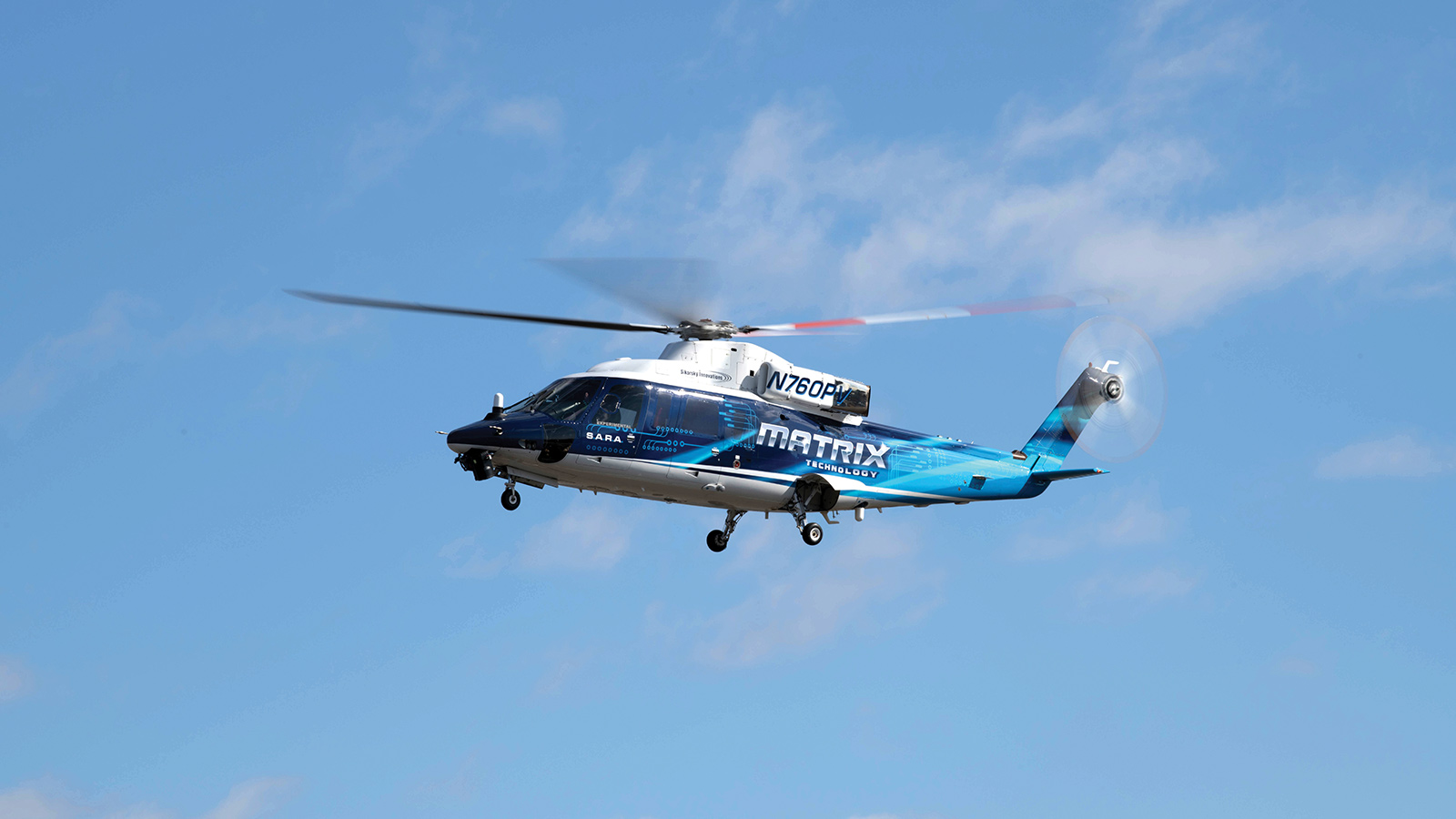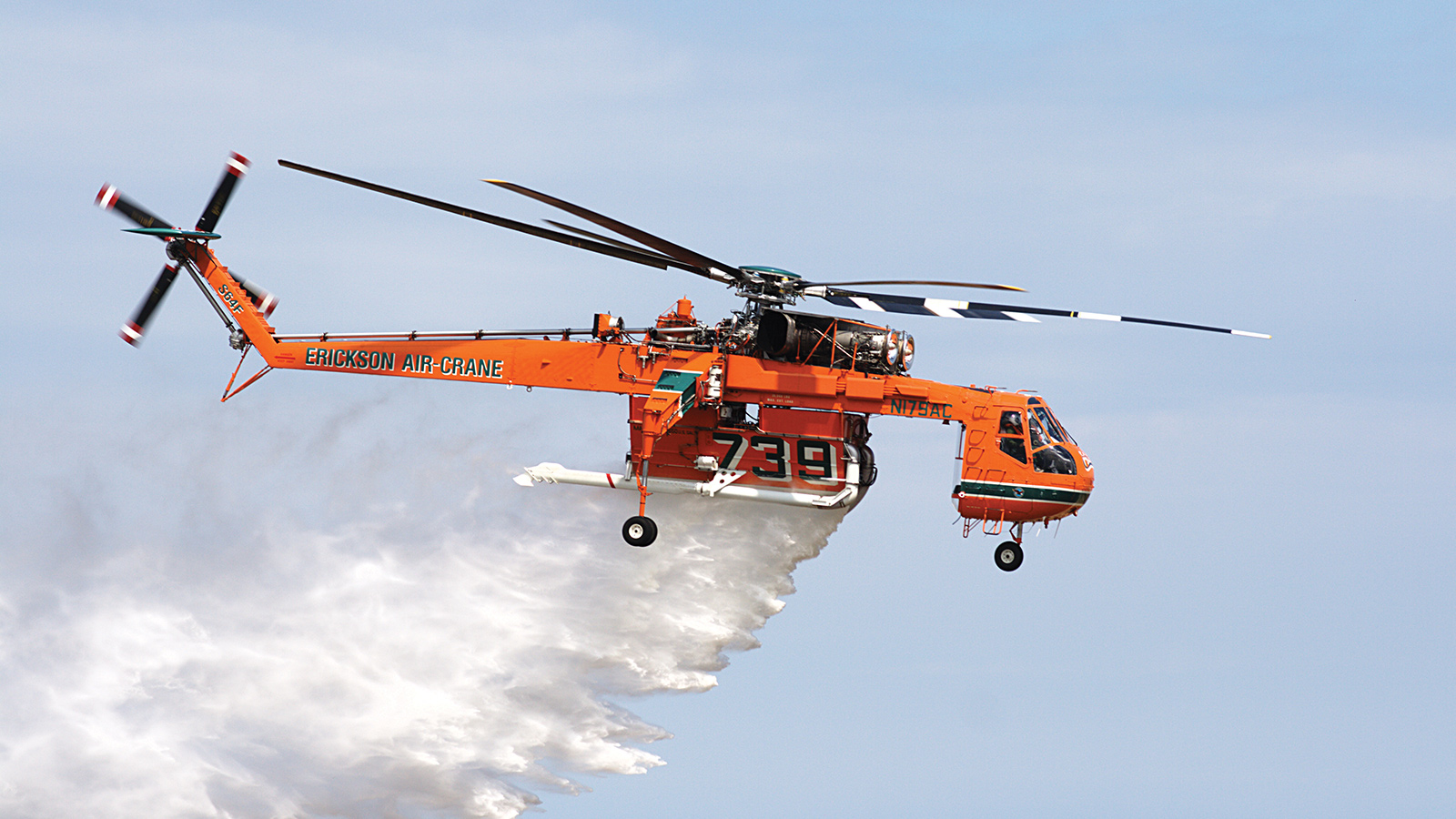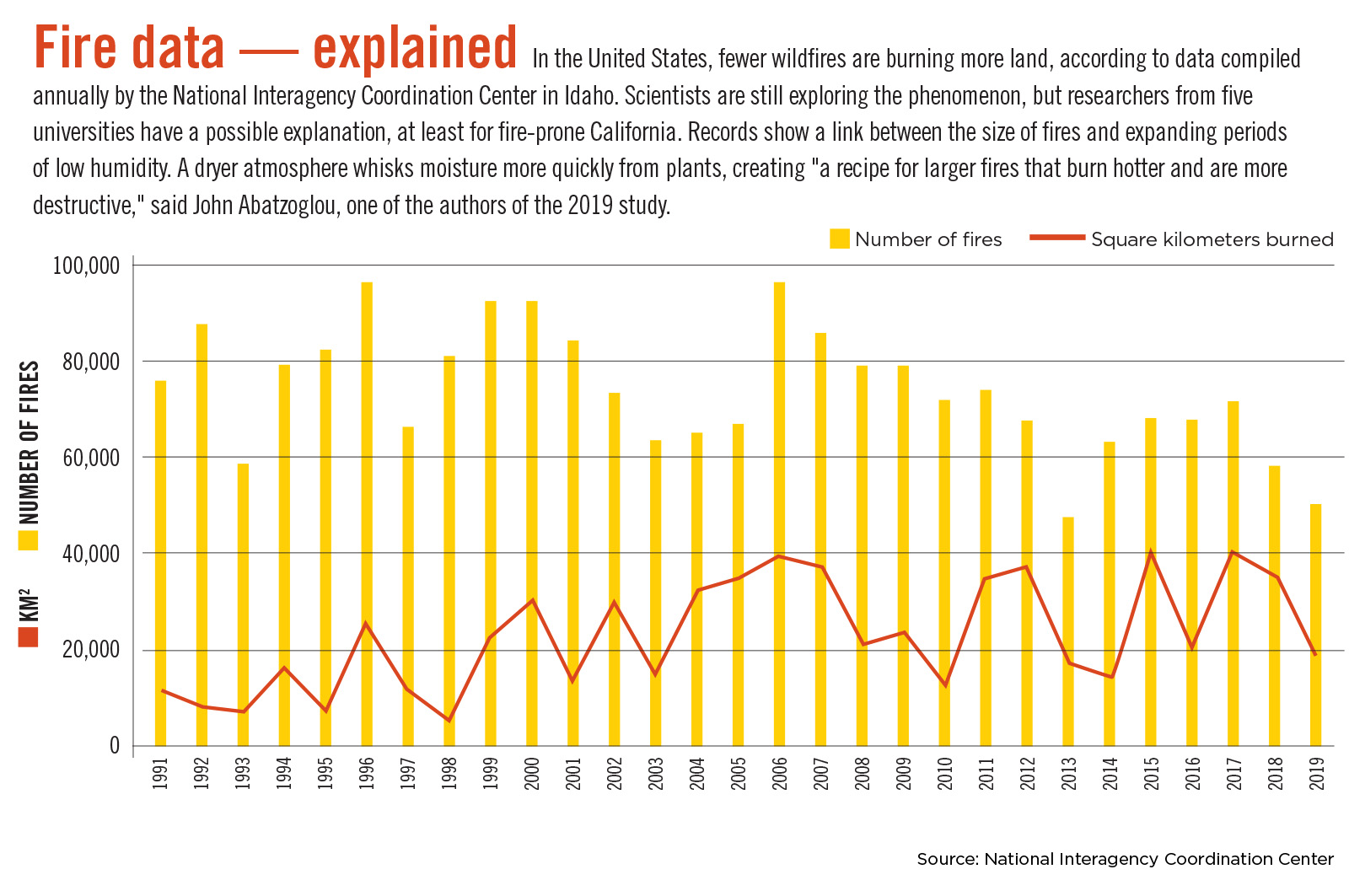Stay Up to Date
Submit your email address to receive the latest industry and Aerospace America news.
The devastating wildfires that ended earlier this year in Australia have energized those in the United States who have long believed that optionally piloted helicopters should be the next great weapon against wildfires. Jan Tegler tells the story.
Battling a wildfire from the air is a dangerous business, but never more so than at night. Too often, aerial firefighting must be suspended after sunset due to poor visibility that could lead to a collision with other aircraft or terrain. That spells a lost opportunity, because the lighter winds and lower temperatures common at night are better for dousing flames and cordoning off fires with retardant. Even once the sun rises, morning fog and smoke can keep planes grounded until 10:00 a.m.
In the United States, some would like to fill the void with a coming breed of optionally piloted helicopters that still face regulatory hurdles. Others argue that, at least at night, the focus should be on equipping aircrews with night-vision goggles.
Each view has its passionate supporters.
“A drone the size of a Skycrane? I don’t get it,” says Wayne Coulson, founder of the British Columbia-based firefighting company Coulson Aviation and one of the leaders of the night-vision goggles camp. He is referring to the famous heavy-lift Sikorsky S-64 helicopters whose crews of two drop water or retardant.
Authorities hire Coulson’s company to battle fires with a mix of conventionally piloted fixed-wing aircraft and helicopters, whose crews sometimes don goggles and venture into the night.
Among those in the other camp are two of the most innovative rotorcraft companies in the United States.
Kaman Corp., the pioneering helicopter company based in Connecticut, is in the process of installing a package of control equipment and software into one of its conventionally piloted K-MAX heavy-lift helicopters as a step toward creating a class of optionally piloted helos, or OPHs for short. Plans call for a series of uncrewed test flights of this K-MAX UAS aircraft with a safety pilot aboard in November at Kaman’s Bloomfield plant. For about $3 million, a K-MAX UAS kit of cameras, datalinks, software and more can turn a K-MAX into an OPH capable of being flown autonomously or with a pilot either aboard or in a ground control station.
Not to be outdone, Lockheed Martin’s Sikorsky Aviation company, also based in Connecticut, in 2022 plans to test fly an aerial firefighting helicopter with its own kit of cameras and software and more called Matrix. The business model is distinct from Kaman’s in that just about any helicopter could be turned into an OPH, or any fixed-wing plane into an optionally piloted one. The company would not provide a cost figure for Matrix, saying it varies, but a potential customer who follows the market says the prices would be similar to Kaman’s.
Matrix provides an aircraft “adjustable levels of autonomy,” says Igor Cherepinsky who directs autonomy programs at Sikorsky. In a crewed configuration, it automates some flight control functions as a “digital copilot” to reduce pilot workload. Or Matrix can fly an aircraft autonomously without a pilot aboard.
One of Coulson’s competitors, Erickson Inc. of Oregon, which flies Skycranes against wildfires under the brand name Air-Crane, reached a development agreement with Sikorsky in January to jointly install and test fly Matrix on an Air-Crane.
The first of those flights will be an “augmented” one, meaning Matrix will assist the safety pilots aboard, Cherepinsky says. Sikorsky also plans to conduct flights of a Sikorsky S-70 at an FAA UAS test site without pilots and only Matrix aboard. If all goes well, Sikorsky and Erickson will retrofit kits on its fleet of 18 Air-Cranes to transform them into optionally piloted S-64s, says Jeff Baxter, Erickson’s director of research and development.
Turning point
Support for flying drones, and by extension OPHs, against fires dates back to 2006 at the U.S. Department of the Interior’s Office of Aviation Services. A turning point seemed at hand in 2014 and 2015, when OAS carried out demonstrations of aerial firefighting with an uncrewed K-MAX like the two that delivered cargo at night to U.S. Marines at remote outposts in Afghanistan. The K-MAX flew at the New York state FAA UAS test site and Lucky Peak Helibase in Idaho.
Nothing came of those flights. The Interior Department, the Forest Service, the U.S. Department of Homeland Security’s U.S. Fire Administration and local and state agencies “prioritized available resources” toward integrating existing uncrewed aircraft, such as 3D Robotics’ small camera-carrying Solo drone, into firefighting ahead of optionally piloted helicopters, explains Mark Bathrick, the OAS director.
Even so, OPHs are going to be a “game-changer,” he predicts, and not just at night. The first hours of daylight can be marked by fog, haze and smoke that make conventionally piloted flights too hazardous as well. All told, piloted flight can typically be conducted for only about eight hours a day, Bathrick says. If a fire were to break out overnight, that can mean a late start. “Optionally piloted helicopters could give us the capability to fly initial attack” — the first opportunity to drop retardant or water — “during the 16 hours we don’t fly now,” Bathrick says.
Bathrick adds that crewed or uncrewed OPH could employ their on-board infrared navigation and targeting cameras to provide the “first-ever” real-time measure of the effectiveness of water and retardant drops on wildfires. “The first water drop on a wildfire was done in 1930, and we still can’t measure drop effectiveness,” Bathrick notes.
Those measurements also would permit authorities to decrease the number of aircraft over a fire, Bathrick says. Crewed aircraft or UAS flown strictly for fire monitoring or mapping could be eliminated from the mix of aerial operations. Jake Sjolund, the tactical air chief at the California Department of Forestry and Fire Protection, or Cal Fire, likes this concept, but he says the agency has no plans to buy OPHs in the near future. According to Cal Fire, it operates the largest department-owned aerial firefighting fleet in the world, with 50 aircraft, including 12 UH-1H Super Huey initial attack helicopters.
Cal Fire is in the process of replacing those Super Hueys with 12 Sikorsky S-70i Firehawks, the newest aerial firefighting version of the company’s UH-60/S-70 medium-lift helicopter. Each UH-60/S-70 can transport firefighters or drop somewhat more suppressant or retardant than a K-MAX but far less than an Air-Crane. Specifically, it releases 3,875 liters — a quarter the volume of a small tank truck — from its external tank, compared to 10,031 liters for the Air-Crane and or 2,290 liters for the K-MAX.
In several years, when OPH technology is proven, affordable and certified, the state agency will “pick up the technology and help take it to the next level,” Sjolund says.
Owning the night
Coulson says the benefits of fighting fire at night can be realized sooner by equipping crews with night-vision goggles, or NVGs for short, and that his company has in fact conducted about 60 such missions so far. After years of training flights, the state of Victoria in Australia contracted Coulson in 2017 and 2018 to carry out NVG flights, and the next year Coulson flew NVG missions for the Orange County Fire Authority in Southern California. Each mission requires two helicopters. A three-person crew flies a Sikorsky S-76 at about 2,000 feet in a supervisory role. An air attack officer seated next to the pilot tells the camera operator seated behind them where to point the infrared device mounted on the aircraft’s nose. Once the attack officer, who views the blaze on a 36-centimeter TV screen, decides which part of the fire to target, the camera operator designates the target with a laser. Nearby is an S-61 helicopter, whose two crew members see this laser show up brightly on their NVGs. The S-61 crew follows the beam and drops up to 4,000 liters of water to douse the flames or retardant to block the fire’s path.
“It takes practice and experience, but it’s effective,” Coulson says.
Bathrick strikes a less upbeat tone about NVGs than Coulson. “Given the expensive, lengthy and graduated training regimen required to safely employ NVGs, they offer a limited return on a significant and recurring investment,” he says.
NVGs also cannot address a broader problem: Half of the present coverage gap in aerial firefighting occurs during daylight when thick smoke over fires cuts visibility. The resulting darkness might seem like night, but in reality, “NVGs are useless during daylight, even in smoke,” Bathrick cautions.
Origins and cost
K-MAX UAS and Matrix have roots that go back more than a decade. Sikorsky, which was purchased by Lockheed Martin in 2015, began developing and testing autonomous technology sometime before 2010. Kaman developed software and hardware for uncrewed K-MAX flights in the late 1990s. Together, the two companies equipped the two K-MAX helicopters that in Afghanistan delivered 2 million kilograms of cargo to Marines at remote outposts.
Those flights provided inspiration and confidence, if not technical solutions, for the rival designs to come. Romin Dasmalchi, Kaman’s UAS business development lead, describes K-MAX UAS as a “clean sheet design” developed solely by Kaman. He describes the technology as the “next logical step” for operators, an OPH based on the combat-proven K-MAX.
Sikorsky’s Matrix technology was pioneered in part under DARPA’s Aircrew Labor In-Cockpit Automation System program, an effort to develop a tailorable kit to add a high level of automation to existing military aircraft, decreasing pilot workload and enabling operation with reduced crew. In 2013, Sikorsky began flying all components of the Matrix hardware and software architecture on board a modified S-76B it dubbed the Sikorsky Autonomy Research Aircraft or SARA, according to Cherepinsky. In 2018 and 2019, U.S. Army pilots flying SARA executed autonomous takeoff, transit and landing, obstacle avoidance, automatic landing zone selection and low altitude ground contour flight, employing Matrix’s lidar and infrared cameras. The current version is scheduled to fly aboard an Erickson Air-Crane in 2022.
Also, Cherepinsky says that Matrix autonomy will be integrated into the SB-1 Defiant and S-97 Raider helicopters the company is offering for the U.S. Army’s Future Vertical Lift program. A large buy like that could reduce the unit cost of Matrix.
“We’re quite aware that unfortunately the funding for fire folks is tiny,” Cherepinsky notes. “We are trying to get to economies of scale.”
Getting costs down for Matrix and K-MAX UAS could be critical for these technologies to gain traction in firefighting. Some authorities do not have large fleets of aircraft of their own, so they rely on the Forest Service and Interior Department to hire companies such as Coulson and Erickson to help them battle fires. Funds for doing so appear to be dwindling. Records on the GovTribe.com website show that the total value of contract awards fell from $575 million in 2017 to $125 million in 2020.
At this rate, “no one’s going to be able to afford to retrofit an S-64 or K-MAX,” says Steve Athanas of Swanson Group Aviation in Oregon, which flies helicopters for firefighting and other needs.
Swanson hopes this will change, and the company has decided to spend roughly $5 million, possibly before the end of the year to convert its two existing K-MAXs into K-MAS UAS aircraft. Athanas says his contract with Kaman Aerospace gives him the option of delaying the purchase “dependent on what the FAA rules as far as certification.”
So how will Erickson, the inaugural Matrix customer, afford equipping its 18 S-64s with the kits? Although “Matrix will be an expensive, long program,” says Baxter, the company expects the cost of operating OPH to fall below the cost of flying crewed helicopters over the long term.
“If I were to step back and say, ‘What’s the cheapest way I can fight fire at night now?’ I’d go put night-vision goggles on and risk a crew in a lead plane and a crew in a helicopter at night in bad environments and I’d make money,” he says. “But NVGs definitely don’t have a long-term advantage because I’ll be able to launch the same mission with nobody on board an S-64.”
Bathrick of the Interior Department says contractors could make up for the cost of OPH kits through a higher operating tempo. “They’d benefit greatly from being able to triple the amount of time their helicopters could be used on wildfires,” he says.
Regulatory hurdle
As far as the technology is concerned, Athanas is enthusiastic about OPH, preferring the potential of flying uncrewed K-MAX UAS at night to the safety risks of routinely flying with NVGs.
The question has been the disposition of FAA regarding OPH. Some OPH flights could be conducted by the Interior Department or Forest Service without FAA certification, if FAA were to establish a TFR, or temporary flight restriction, zone during a fire. Only particular aircraft, OPH in this case, would be permitted to fly in the TFR.
Still, OPH backers want the larger market that FAA certification would bring. It’s unclear to them whether that certification will be forthcoming. FAA has no timeline for approving certification of “operations of unmanned aircraft fighting fires presently,” says Victor Wicklund, deputy director of FAA’s aircraft certification service policy and innovation division.
Such a certification would include guidance about flying conditions. “Unmanned is going to be the way to go if the FAA would just come through with its guidelines,” Athanas says.
He worries that when or if the guidelines do come, they “could be stifling.” The FAA could, for example, stipulate that “you may conduct night unmanned firefighting missions as long as there are no ground personnel within 2,000 feet of the vehicle’s flight path. In that case the mission would be impractical due to the presence of ground firefighting personnel,” he says.
Despite this uncertainty, preparations for the OPH demonstration flights continue. Baxter of Erickson says uncrewed demonstration flights will begin in 2024 and “there is no technical reason” that uncrewed operations “couldn’t start that same year.”
Cybersecurity and insurance
Managers are increasingly concerned about the cybersecurity of uncrewed flights, whether by aircraft designed from the start to fly uncrewed or by helicopters equipped with the Matrix or K-MAX UAS equipment.
In late January, U.S. Secretary of the Interior David Bernhardt signed an order of “temporary cessation of non-emergency unmanned aircraft systems fleet operations,” given that Interior had been flying small uncrewed aircraft in its firefighting efforts. The order cited cybersecurity concerns and the use of foreign-made drones.
Drones can still be flown in fire emergencies, at least for now, but the pioneers in the field know that this issue must be addressed. Sikorsky says it takes “cybersecurity seriously to ensure all our systems — mature and developmental — are protected.” Kaman says its K-MAX UAS are well protected against cybersecurity threats, noting that the uncrewed K-MAXs it flew in Afghanistan were never compromised.
Insurance is another issue. Until the safety of flying OPH uncrewed is demonstrated at the intersection where wildfires are most urgently fought — where they threaten people and property — K-MAX UAS and Matrix won’t be operated.
“Right now, no company is going to insure a 20,000-pound helicopter with no pilots aboard flying over people’s heads, houses or buildings to go fight a fire at night,” Coulson says. “Aerial firefighting with OPH is a good number of years away.”
In Cherepinsky’s view, “We have fly-by-wire aircraft flying over our heads every day and we’re OK with it because certain standards exist. The same amount of rigor gets put into the Matrix system and all of its sensors. We can do this.”
And so, the debate continues.
About Jan Tegler
Jan covers a variety of subjects, including defense, for publications internationally. He’s a frequent contributor to Defense Media Network/Faircount Media Group and is the author of the book “B-47 Stratojet: Boeing’s Brilliant Bomber,” as well as a general aviation pilot.
Related Posts
Stay Up to Date
Submit your email address to receive the latest industry and Aerospace America news.








